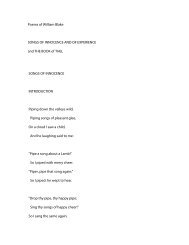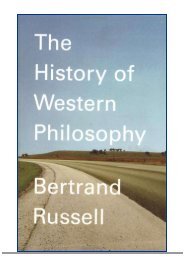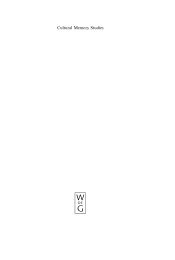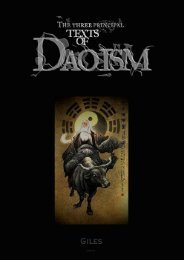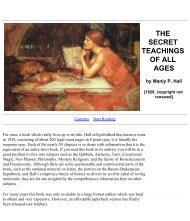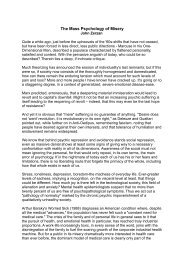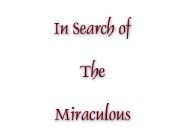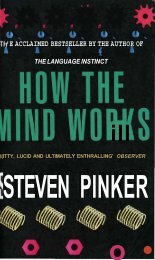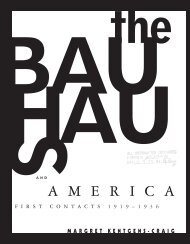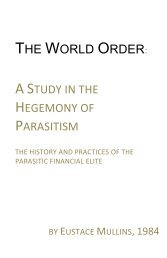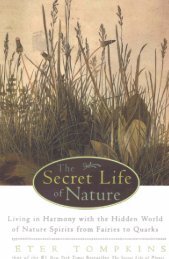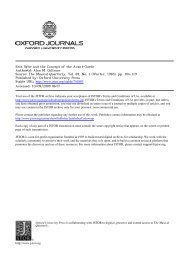The Ever-Present Origin - Michael Goodnight - Editor
The Ever-Present Origin - Michael Goodnight - Editor
The Ever-Present Origin - Michael Goodnight - Editor
- No tags were found...
Create successful ePaper yourself
Turn your PDF publications into a flip-book with our unique Google optimized e-Paper software.
discovery of Augustine's words. "I admit I was overcome withwonderment," he continues; "I begged my Brother who also desired toread the Passage not to disturb me, and closed the book. I was irritated forhaving turned my thoughts to mundane matters at such a moment, foreven the Pagan philosophers should have long since taught me that thereis nothing more wondrous than the soul [nihilpraeteranimumessemirabile],and that compared to its greatness nothing is great."Pausing for a new Paragraph, he continues with these surprising words:"My gaze, fully satisfied by contemplating the mountain [i.e., only after aconscious and exhaustive survey of the Panorama], my eyes turnedinward [in me ipsuminterioresoculosreflexi]; and then we fell silent . . "Although obscured by psychological reservations and the memory of hisphysical exertion, the concluding lines of his letter suggest an ultimateaffirmation of his ascent and the attendant experience: "So muchperspiration and effort just to bring the body a little closer to heaven; thesoul, when approaching God. must be similarly terrified.”<strong>The</strong> struggle initiated by his internalization of space into his soul - or, ifyou will, the externalization of space out of his soul - continued in Petrarchfrom that day on MountVentoux until the end of his life. <strong>The</strong> old worldwhere only the soul is wonderful and worthy of contemplation, asexpressed succinctly in Augustine's words "Time resides in the soul," nowbegins to collapse. <strong>The</strong>re is a gradual but increasingly evident shift fromtime to space until the soul wastes away in the materialism of thenineteenth century, a loss obvious to most people today that only themost recent generations have begun to counter in new ways.<strong>The</strong> transition mirrored in Petrarch's letter of six hundred years ago wasprimarily an unprecedented extension of man's image of the world. <strong>The</strong>event that Petrarch describes in almost prophetic terms as "certainly ofbenefit to himself and many others" inaugurates a new realistic,individualistic, and rational understanding of nature. <strong>The</strong> freer treatmentof space and landscape is already manifest in the work ofAmbrogioLorenzetti and Giotto; but although Giotto's landscape with itshill motifs, for example, is still a predominantly symbolic representation ofUmbrian nature, his treatment represents a decided shift away from theunperspectival world. This shift is continued by his apprentices,FraAngelico and Masolino, and later by Paolo Uccello and the brothersLimbourg (in the Très riches heuresduDuc de Berry), who elaborateperspectival painting with ever greater detail. What Giotto merelyanticipated, namely the establishment of a clear contour of man, is firstachieved by Masaccio. It is a characteristic also expressed in AndreaPisano'sreliefs, particularly in his "Astronomer's relief" on the campanile inFlorence, and notably evident in the works of Donatello. We must alsoremember Lorenzo Ghiberti, whose early Bronze relief, the "Sacrifice ofIsaac"(1401-02),is a remarkably authentic rendering of free, open, andunenclosed space. To the extent that a relief is able to convey spatiality,this relief depicts a space where neither the transcendental goldillumination nor its complement, the darkness of the all-encompassing16



